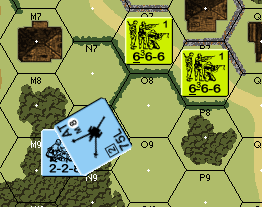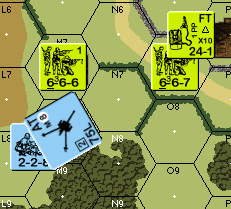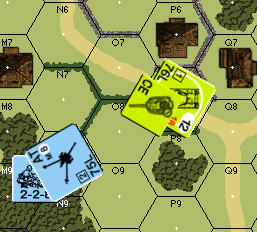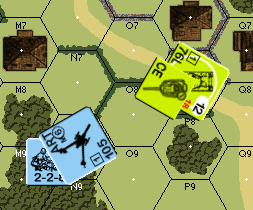Introduction
This article is based on a suggestion from a reader. I admit I usually have to look up the rules in this section. Authoring this is also reacquainting me with the rules. Let’s begin.
Discussion
Section C11 covers all the rules discussed in this section. Right off we learn “hits” against a Gun represent two types; a “Near Miss” which is close enough to affect the crew and a “Direct Hit” which actually strikes the Gun. We will discuss these terms when we talk about IFT results.
All Guns are Emplaced if they meet the conditions of C11.2. Emplaced Guns receive a +2 TEM which may not combine with other positive TEM. You can use Area Target Type(ATT) or Infantry Target Type(ITT) to attack Guns. If attacked using ATT the Emplacement TEM applies on the IFT DR. If attacked using ITT the Emplacement TEM applies to the To Hit (TH) DR.
Direct Hits
A Critical Hit (CH) is a Direct Hit. It automatically destroys the Gun and its manning Infantry without the need to roll on the IFT.
Other attacks against a Gun are resolved on the IFT. Attacks using AP\APCR\APDS\HEAT attack using HE equivalency. If the IFT Final DR, prior to any gunshield DRM, is a KIA\K/# the Gun has taken a Direct Hit. A KIA eliminates a Gun and its manning Infantry. A K/# malfunctions the Gun and Casualty Reduces its manning Infantry. Gunshield DRM NEVER applies to a Direct Hit. More on this shortly.
Near Miss
Any other result on the IFT is considered a Near Miss. A gunshield DRM applies to Near Misses if it qualifies (C11.4).
Gunshield
Not understanding how a gunshield works is the greatest source of confusion. For starters, only Anti-tank (AT) and Infantry (INF) Guns have a gunshield. If you are attacking an AT or INF Gun, only a Good Order manning CREW might receive the benefit of the gunshield. The gunshield will only apply to attacks from within the Gun’s Covered Arc (CA). The DRM does not apply to attacks from within its own hex. The DRM does not apply when pushing the Gun. It is also not applicable if the crew is moving to the Gun for the purposes of re-manning the Gun. A gunshield is never cumulative with other positive TEM in the Location, including Emplacement.
Gunshield DRM never applies to a TH DR. They can modify the effects of a Near Miss on the IFT even if TEM has already modified the TH attempt. This is a little confusing so we will discuss it in the examples below.
Examples
Example 1

The American Infantry attacks the German AT Gun. We will ignore cowering for this example. The attack originates within Gun’s CA so the gunshield may apply. The Gun is also Emplaced. The German may choose between the +2 Emplacement TEM or the +2 gunshield DRM. Note this is an attack on the IFT and is NOT considered a “hit”. Any possible gunshield DRM would not apply unless used in place of TEM. To resolve, roll directly on the IFT and apply the results normally, including Random SW/Gun Destruction (A9.74).
Example 2

The American 6-6-7 attacks the non-Emplaced German AT Gun with the flamethrower. Per C11.5 a gunshield does not affect an attack by a flamethrower. As there are no DRMs this attack is more likely to destroy or malfunction the Gun. As with example 1, roll directly on the IFT and resolve the attack normally, including Random SW/Gun Destruction (A9.74).
Imagine the Gun survives this initial attack. Now the 6-6-6 wishes to attack using a MOL. The gunshield DRM does not apply to a MOL attack (C11.5) unless the attack also includes the unit’s Inherent Small Arms.1 The attack would be 16 +2 if adding Small Arms and 4 +0 if using only MOL to attack. In either case the unit would be marked as fired for the appropriate phase. Resolve the attack normally on the appropriate IFT column including the possibility of Random SW/Gun Destruction.
Example 3

The American tank fires its Main Armament at the German Gun using ITT. The TH DRMs are -1 Case L, +1 Case P, and +2 Emplaced TEM (Case Q) for a Final +2 TH DRM. Recall a gunshield never affects the TH DR. The American rolls a 1,1 Original TH DR resulting in a Final TH DR which is not less than half the Modified TH# of 8. A subsequent dr of 5 means this is not a CH. (Had the dr been <= 4 a CH would result and the Gun and its manning Infantry would be automatically eliminated). For a more thorough explanation of ITT Critical Hits see my previous article titled Infantry Target Type and Critical Hits.
A 76L Gun using HE attacks on the 12 column. An Original DR of 2 results in a 1KIA (Direct Hit). The gunshield is NA and the resulting KIA destroys the Gun and eliminates the manning Infantry. An Original DR of 3 results in a K/3, also a Direct Hit. Again, the gunshield is NA. The K/3 malfunctions the Gun and Casualty Reduces the crew (i.e., eliminates it). A DR of 4 through 10 results in a Near Miss. The gunshield DR applies to the IFT attack even though TEM has already modified the TH DR. A 4 through 7 results in some level of Morale Check. An 8 is a Pin Task Check. A 9 or greater is a complete miss.
Example 4

This is nearly the same example as above. The difference this time is the Gun is an Artillery (ART) piece and no longer a small target. The Final TH DRMs would be +1 rather than +2. Assume the Gun is hit and it is not a Critical Hit. Again, the attack takes place on the 12 column. The results for an Original 2 and 3 DR on the IFT remain unchanged. This time, there is no gunshield in play. As such, any Original DR of 4 through 9 results in some level of Moral Check. An Original 10 is a PTC. And Original 11 or greater is no effect.
Example 5
For example 5 we need no figure. In this example, Offboard Artillery (OBA) or a Demolition Charge (DC) attack a Gun. These attacks are resolved as in example 4. Neither attack needs to roll a TH attempt. Resolve each on the appropriate IFT column. Each of these types of attacks can apply the gunshield DRM in spite of not needing to first secure a hit per C11.4. For instance, 80mm OBA would attack on the 16 column. Assuming +2 Emplacement TEM, an Original 2 would be a CH eliminating the Gun and manning Infantry. An original 3 or 4 is modified by the +2 Emplacement TEM for a Final 5 or 6 on the IFT. Since these are both Near Misses any applicable +1 gunshield DRM applies to the final result against the manning Infantry should the player elect to not use emplacement TEM.
Example 6
Lastly, a mortar attacks a Gun by Indirect Fire. Such attacks can be Direct Hits or Near Misses. As normal, Direct Hits would not apply the gunshield DRM. Near Misses would (even from positions outside of the Gun’s CA).2 Again, an 81mm mortar attacks a Gun using ATT. A TH DR of 1,1 is a CH eliminating the Gun and manning Infantry. Any Emplacement/TEM would modify a 3 through a 9 first. This makes a 3 through 9 a Near Miss. Should the player opt for the gunshield in lieu of TEM, the 3 through 9 are further modified by a +1 gunshield DRM (for Indirect Fire) on the IFT.
Conclusion
As always, I hope this helps in some small way. Let me know if you have suggestions for further articles in the comments below. — jim
Version 1.2
If the FP of a FG attacking a Gun includes both MOL and Small Arms Fire, could a gunshield DRM modify the attack?
A. Yes, but the FG could opt to decline its Small Arms Fire and attack only with the MOL to avoid the gunshield DRM.
[Gen24.2; An95w; An96;Mw]
A. Only if it is a 20L (i.e., 20 mm) ATR. [An93a; An95w; An96; Mw]
Does Indirect Fire from OBA have to originate within the guns current CA for the gunshield DRM to apply? Does Indirect Fire from on-board Mortars have to originate within the guns current CA for the gunshield DRM to apply?
A. No to both; see 11.4; (“all forms of Indirect Fire” includes attacks which do not “originate within its current CA.”)


Great article Jim, thanks. How about an article on shooting at landing craft? Both direct and indirect fire, and how it affects the craft and its contents. – Woody
I will give it some thought. I don’t feel too confident with this topic as I haven’t played with landing craft very often. Even then, it has only been the river-crossing type scenario where I am rowing across the river.
Thanks Jim. Barring that, how about indirect fire at AFV’s? Shooting mortars at tanks can be tricky to resolve correctly.
That’s a good idea. I will add it to the list. It may take me a bit to get to while I focus on finishing up the prisoner article I am working on.
Some excellent articles, and great that you are adding to them so regularly. Very clear explanations and good to see illustrations included too.
An article on options against AFVs as they move ADJACENT in early war situations with a lack of LATW, leaving most infantry frustrated unless street fighting, or VBM into the defenders hex, would be much appreciated. If no overrun is being attempted infantry seem limited in their response until their own CC Phase comes around, unless the AFV is particularly thin skinned, or low AF.
Thanks for your feedback. I appreciate it. It really helps to hear that people are finding them useful. It keeps me going on these.
Let me give some thought to this. I have an article scheduled for 25 October which is covering the basics of how I approach a scenario-concepts I call my ASL Maxims. Once I have posted that article, I will have a framework to begin making a series of articles on tactics. I will circle back to this then.
Thanks for the suggestion.
Great explanation! It teach me some bits I had previously missed.
In one of my now playing games, a russian 458 squad had to crew a 76L (an ART gun, but there is a 45L AT without crew around) in a brush hex after the crew broke. That, I think, was a desperate move. It lowers a lot the chances of that gun.
Excellent article but could you clarify the position with regard to indirect fire? You appear to be saying that the +1 gunshield modifer can be added to any emplacement TEM in a “near miss” situation. C11.2 says that the crew can apply emplacement or gunshield TEM but not both. Am I misreading something?
Which example? There are cases when you can use TEM AND the Gunshield DRM and cases where you can’t. Since you are using +1 DRM, I assume you are referring to example 6. I refer you to C11.5, last sentence: “A gunshield DRM never affects a To Hit DR, but can be used to modify the effects of a Near Miss Hit even if a TEM was already used to modify the To Hit attempt.” Since this is ATT, it may be more accurate to say you could chose between the TEM or the Gunshield in this case. I amended the original article to reflect this more precise language. Thanks for your question.
Hi Bishop,
Excellent article, like the others you have written.
If you will allow me, I would also add to this article something about A9.74 (rule mentioned in table C11.6 “GUN DESTRUCTION TABLE”) because a Gun can also be a target of random or intentional destruction by:
– an overrun Attack;
– An overrunning, fully-tracked AFV which ends its MPh* in a target Location (Guns and abandoned weapons even if the OVR did not result in a KIA unless the weapon is in an entrenchment);
– Specific fully-tracked AFV OVR attack vs a Gun (automatically destroy any Gun/SW therein not in an entrenchment);
– Random SW/Gun destruction occurring in CC.
* also in “motion” status (D2.4)?
Translated with http://www.DeepL.com/Translator (free version)